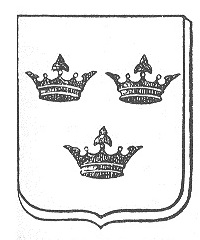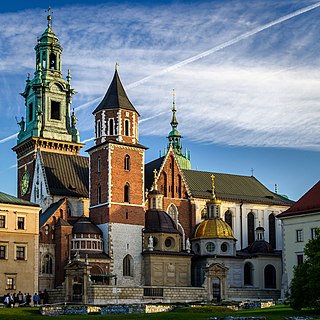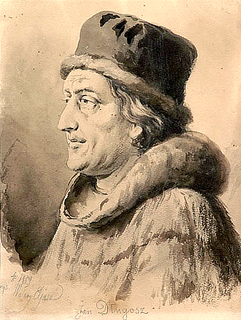
Jan Długosz, also known as Ioannes, Joannes, or Johannes Longinus or Dlugossius, was a Polish priest, chronicler, diplomat, soldier, and secretary to Bishop Zbigniew Oleśnicki of Kraków. He is considered Poland's first historian.

Przemysł II, was the Duke of Poznań from 1257–1279, of Greater Poland from 1279–1296, of Kraków from 1290–1291, and Gdańsk Pomerania (Pomerelia) from 1294–1296, and then King of Poland from 1295 until his death. After a long period of Polish High Dukes and two nominal kings, he was the first to obtain the hereditary title of king, and thus to return Poland to the rank of Kingdom. A member of the Greater Poland branch of the House of Piast as the only son of Duke Przemysł I and the Silesian princess Elisabeth, he was born posthumously; for this reason he was brought up at the court of his uncle Bolesław the Pious and received his own district to rule, the Duchy of Poznań in 1273. Six years later, after the death of his uncle, he also obtained the Duchy of Kalisz.

Stanisław Dziwisz is a Polish prelate of the Roman Catholic Church. He served as Archbishop of Kraków from 2005 until 2016. He was created a cardinal in 2006. He was a long-time and influential aide to Pope John Paul II, a friend of Pope Benedict XVI, and an ardent supporter of John Paul's eventual beatification.

Stanislaus of Szczepanów, or Stanisław Szczepanowski, was a Bishop of Kraków known chiefly for having been martyred by the Polish king Bolesław II the Bold. Stanislaus is venerated in the Roman Catholic Church as Saint Stanislaus the Martyr.

John Albert Vasa was a Polish cardinal, and a Prince-Bishop of Warmia and Kraków. He was the son of Swedish and Polish King Sigismund III Vasa and Austrian archduchess Constance of Austria.

Pobóg is a Polish coat of arms that was used by many noble families in medieval Poland and later under the Polish-Lithuanian Commonwealth.

Jastrzębiec is a Polish coat of arms. It was used by several szlachta families prior to and during the Polish-Lithuanian Commonwealth, and is still used to the present day. During World War II and the communist reform, many families lost their commonwealth status, as well as their right to their manors and sometimes vast lands.

Jakub Świnka was a Polish Catholic priest, the Archbishop of Gniezno and a notable politician, supporter of the idea of unification of all Polish lands under the rule of Władysław I the Elbow-high. His coat of arms was Świnka.
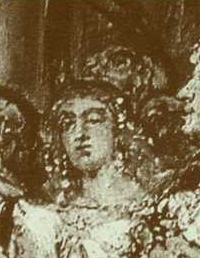
Bezprym was a Duke of Poland from 1031–1032.

Stanisław Samostrzelnik was a Polish Renaissance painter, miniaturist, decorator and Cistercian monk from Kraków, Poland. He was the first Polish painter known by name who painted in the Renaissance style. There are many frescos by him in the churches of southern Poland. The most distinguished can be seen in the Cistercian monastery in Mogiła. He is also recognized for his portrait of Bishop Piotr Tomicki in the portrait gallery of the Church of St. Francis of Assisi, Kraków.
Nicolaus or Mikołaj Szyszkowski (1590–1643) of Ostoja coat of arms was a Prince-bishop of Warmia from 1633 until his death in 1643.

The Archdiocese of Wrocław is a Latin Rite archdiocese of the Catholic Church named after its capital Wrocław in Poland. From its founding as a bishopric in 1000 until 1821, it was under the Archbishopric of Gniezno in Greater Poland. From 1821 to 1930 it was subjected directly to the Apostolic See. Between 1821 and 1972 it was officially known as (Arch)Diocese of Breslau.
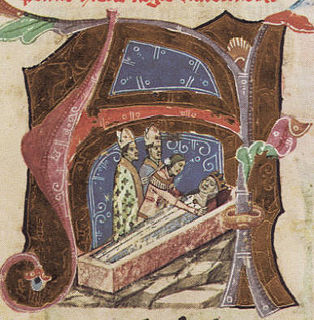
Maria of Bytom, was a Queen of Hungary by marriage to Charles I of Hungary.
Lambert Mieszkowic, was a Polish prince of the House of Piast.

Władysław Oporowski (1395–1453) was a Polish medieval political and religious leader. Deputy Chancellor of Poland (1429–1434), Bishop of Kujawy (1434–1449), archbishop of Gniezno and primate of Poland (1449–1453). It is recognized that he was a much better diplomat and politician than church official.
Bolesław the Forgotten or the Cruel was a semi-legendary Duke of Poland of the Piast dynasty from 1034 until his death in 1038 or 1039. He was allegedly the first-born son of Mieszko II Lambert.

Bolesław II the Generous, also known as the Bold and the Cruel, was Duke of Poland from 1058 to 1076 and third King of Poland from 1058 to 1079. He was the eldest son of Duke Casimir I the Restorer and Maria Dobroniega of Kiev.

The Bishop's Palace in Kraków is the seat of Kraków metropolitan Curia, Poland, and the traditional residence of Kraków bishops since the late 14th century. It is the second largest palace in the city after Wawel – former seat of the Polish monarchs. It is part of a monastery complex of the Franciscan Religious order. Bishop's Palace is best known for being the residence of Pope John Paul II during his stays in the city. He used to give his blessings and talk to his followers from a window above the main entrance at night.
Lambert III was a Bishop of Kraków from 1082 to 1101 AD.
